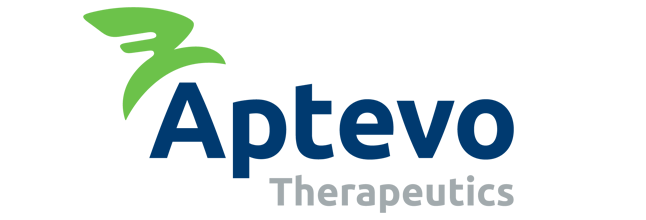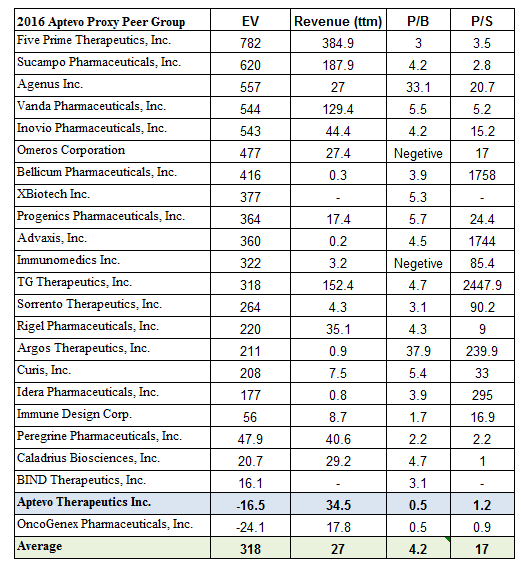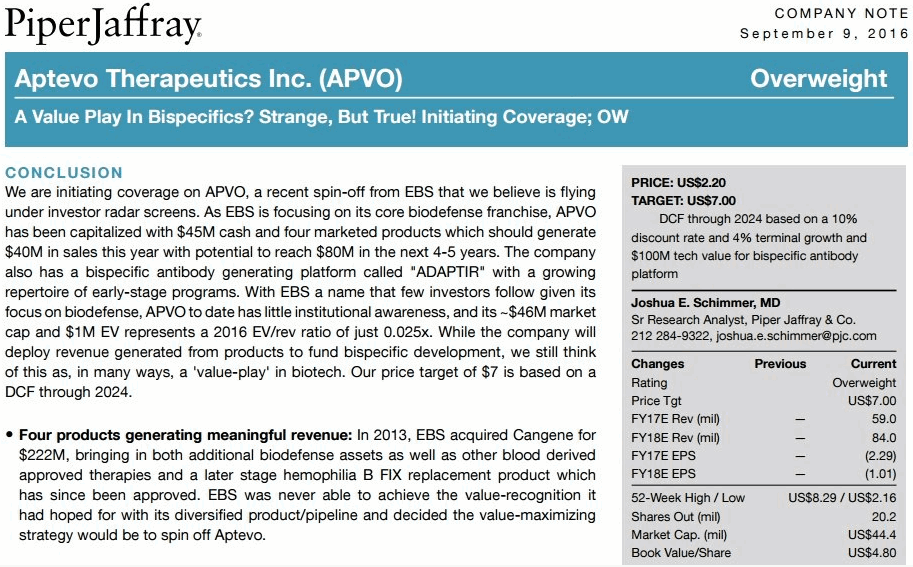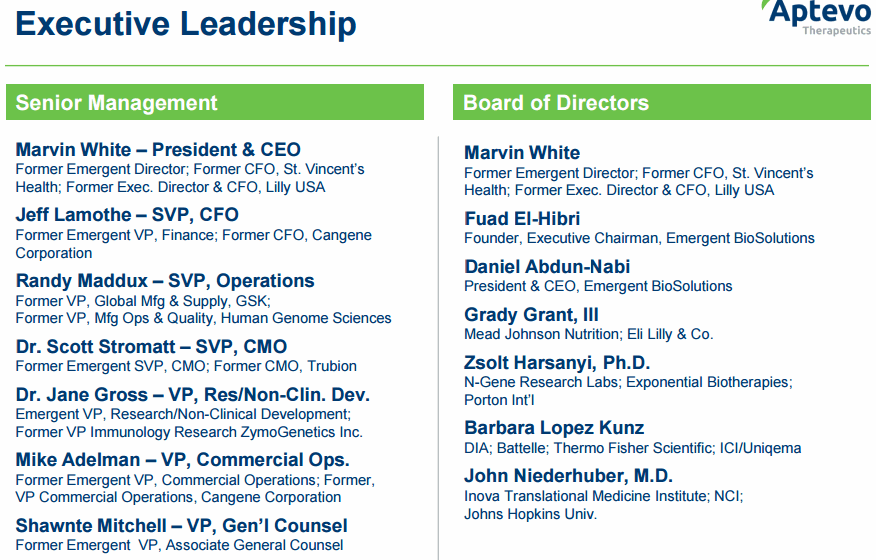I bought Aptevo Therapeutics (APVO) to the spin-off portfolio at $2.40.
Note: This is a biotechnology company with high risk profile.
* * *
Six months ago, I bought shares of Nuvectra Corporation (NVTR) – a small US medical device company which has developed a platform for the treatment of neurological disorders, which was separated via spin-off from Greatbatch. A month after buying it, it increased by over 100% and was sold out of the portfolio. I bought the stock not because I’m an expert in the field, but because of the great pricing distortion in which the stock traded – it was traded at a market value of $48 million while it had $75 million of cash on hand and zero debt. The story of APVO seems to be very similar to that of NVTR.
Aptevo is a small biotechnology company (market cap of approximately $45 million), recently separated via spin-off from Emergent Biosolutions, and focuses on the development and sales of drugs for oncology (the study and treatment of cancer) and hematology (blood disorders), and designed to significantly contribute in improving the quality of life of patients. The company’s core technology (patented, of course) is the ADAPTIR platform, which is based on a modular protein technology that can be used in a wide variety of drugs in the field.
The company has four products approved by the FDA in the fields of hematology and Infectious Diseases: WinRho has been sold to patients since 1995, IXINITY was approved in April of 2015 and sold since June 2015, HepaGam B, and VARIZIG, which was approved in 2012 and is the only approved drug for the treatment of patients with the chickenpox. In addition, the company has two drugs in clinical trials and 4 other products in the pre-clinical stages. Some of the products are developed in collaboration with MorphoSys AG, a German biotechnology company that is well established and successful, that can provide strong financial backing for further development and future sales (more details on Aptevo can be found in its presentation and separation document from its former parent company).
Why should we invest in such a small Biomed company?
Aptevo is indeed a small and young biomed company, but its approved drugs are already generating a revenue of tens of millions of dollars a year. In 2014 it had revenues from sales and cooperation of $46 million and in 2015 revenues somewhat declined to $34 million. In the second quarter of 2016 it recorded revenues of over $10 million, and the company estimates that sales in the coming quarters are expected to be at least that size. Despite the risk inherent in the activities of such companies (see “What are the risks” below), does it make sense that a company like Aptevo is traded at a Price/Sales of 1.2, while other companies like it are traded in multiples at least 5-10 times higher?
Oddly, Aptevo with 4 FDA approved drugs, 6 more in the pipeline, $65 million in cash and $40 million in annual sales is traded at valuation similar to OncoGenex Pharmaceuticals, which recently failed in approving its only drug in the pipeline. Of course, some companies in the sector are traded at bubbly multiples, and yet, in this case there seems to be a large distortion in APVO pricing.
Make no mistake, despite the $40 million annual sales, the company is still losing money – approximately $50 million a year. It’s a lot of money for companies like Aptevo. But this is common situation in the development phase as the company cannot give up on the continued research and development of new drugs. The big question in such cases is about its ability to fund operations for a sufficient amount of time. For Aptevo the answer is yes. The company has $65 million in cash, and is expected to receive an additional $20 million (as a loan) from the former parent company in early 2017, and in addition, $15 million, which is the second part of a loan recently received from MidCap Financial (which it will get if the company reaches the target annual sales of more than $40 million). In all, $100 million of cash, which will be sufficient to support the Company’s operations in the next two years without having to issue new shares or taking on additional debt. This will allow the company to easily continue marketing existing products and the new product development progress.
If we go back to the question of pricing, does it make sense that APVO is traded at half of its Book Value? Currently, APVO traded at a market cap of $45 million, even less than the cash it has in its balance sheet. This is very reminiscent of the case of NVTR. Apparently, the analysis company Piper Jaffray, probably think the same, and recently issued a buy recommendation to APVO with a target price of $7 per share while calling it a “Value-Play”.
A mark that indicates success – executives from the parent company chose to go with the subsidiary
One of the most positive signs regarding a spin-off, especially for small spin-offs, is the passage of key personnel from the parent company to spin-off. Think about it, why would executives at a billion dollars’ worth company give up comfortable wages and their job security and go on an adventure in a tiny company worth $45 million? One reason: they believe that it is likely they will increase the small company’s business operations and would make tons of money off it.
That is probably the reason why the founder and former CEO and Chairman of the Board of Emergent Biosolutions – Fuad El-Hibri, decided to move to be Chairman of the Board of APVO, and in addition to hold 14% stake in the company. El-Hibri  has many years of experience in the field, which can contribute a lot to the company both on business and on financing, if necessary.
Also, the president and CEO of the parent company – Daniel Abdun-Nabi, will serve as a director in APVO. Except for them, there is a long list of distinguished directors with many years of experience in the field, as well as a line of senior executives from the parent company who decided to move along with the spinoff. On the top of the list it is possible to note the President and CEO, Marvin White, who served as a director in Emergent, as well as the director of scientific research, the development manager, the finance director and the director of commercial operations, all of which have moved with the spin-off. A look at the paragraph about their compensation in the separation document, indicates that the success of the company will bring a lot of money and shares into their pockets.
What are the risks?
Biomed companies are investments at a high-risk profile. Most are young companies with no revenues, who need a lot of cash to support their research and development expenses. APVO already has a considerable income of $40 million a year, but when subtracting its expenses (around 50 million a year) it is still not sufficient to generate a positive net income. Even the proceeds are not devoid of risks – who promises that the company’s products will be sold in the same extent as in the past two years? Recently there is also a strong opposition to the pharmaceutical companies in the US, led by Hillary Clinton. The main argument is that pharmaceutical companies inflated the prices too much in order to produce profitability to their shareholders, at the expense of patients who have to pay the high price. We should also remember that the pharmaceutical market, especially the biological drug market where APVO’s operation is, is very dynamic, so the competitive advantage of any player is not guaranteed for long time.
I could go on and on about the risks, but in the end the important question is what our APVO investment time frame? In my opinion, the answer is a year or two. Why? Either a positive event that will increase its stock price to around its BV will occur, at which point I will sell it (as in the case of NVTR), or it will be acquired by one of the major players in the industry in the coming years. Now while it is an independent company, it can be done more easily. Until then, the company has enough cash in hand to continue to market their existing products and to promote the development of new products.
Developing new drugs is a matter of years, so the risk of losing the competitive advantages for APVO’s pharmaceuticals is not particularly high. Even the expected election of Hillary Clinton (according to polls), will not be enough to overshadow too much, if at all, the sales of the company, which is not one of the largest pharmaceutical giants who are in the eye of the storm. Still, I classify the investment in the company as a high risk, and recognize that the stock may be quite volatile in the near future.
Bottom line: risky investment, but can be very rewarding
I rarely invest in Biotechnologies companies, surely not ones who are just getting started, but this time it seems to be a very interesting story. First, because APVO has financing for the next two years without the need for the daily chase for additional funding. It is one of the most important things for companies of this type. In addition, the company’s sales of tens of millions of dollars from its existing products. This means it does not only know to develop good products, but to also sell them in practice. This is not trivial – there are many companies that have developed revolutionary products but failed to convince medical establishment officials to buy them.
In addition, it seems that in terms of pricing the stock is undervalued compared to its peers. It makes no sense that such a company will be traded at a market value similar to its annual revenue and half of its BV. In this case the stock even traded below its total cash position (although they’ll burn through it in the next two years). Also, the massive presence of the directors from the parent company who have decided to switch to the spin-off and the substantial holdings of Fuad El-Hibri (founder of the parent company) are things that are hard to ignore.
In my opinion, and assuming that the technology developed by APVO is indeed successful, the company will probably be acquired by one of the major players in the industry, and there are many of them, sometime during the next two years. Obviously, it would be at a much higher value than its current price. However, it’s still a biomed stock, so it can be very volatile along the way. Take this into consideration before you decide to buy it.







Be the first to comment on "Aptevo Therapeutics – huge potential with high risk"